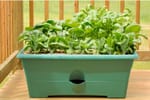Planning a garden can be an exciting and rewarding experience.
Whether you're starting from scratch or just sprucing up your existing garden, the process of designing and planting a beautiful outdoor space is both creative and therapeutic.
It's also surprisingly simple if you take it step-by-step.
From deciding on the right plants to choosing the perfect layout, planning a garden starts with understanding some basic principles of garden design.
With careful consideration of location, soil type, size, shape, and sunlight requirements for your chosen plants, you'll have all the tools you need to create an outdoor oasis that will bring joy for years to come.
Planning your garden will help ensure that everything flourishes, while also helping you avoid unnecessary costs and time-consuming mistakes.
Here are some simple steps to help you plan the perfect garden.
1)) Gather Inspiration
Before you dive into the practical aspects of planning your garden, take some time to gather inspiration.
Look online at images of gardens that you like and make notes on what draws you to them—is it the way they are laid out?
The colors?
The plants?
Make sure to save these images so that they can be referenced later when you begin sketching out your own plans.
2)) Create Your Layout
Now it’s time to create a visual representation of your garden.
If you have access to a graphics program then use this technology to create a digital version of your layout where you can easily experiment with different shapes and sizes for the beds and move images around until it looks right.
If not, no problem! Sketching out your ideas with paper and pencil works just as well —just make sure to measure everything out accurately so that all elements fit together perfectly once construction begins.
3)) Analyze the Environment
Analyze the environment of the garden and determine the necessities for successful planting.
Consider the size, location, sunlight exposure, soil type, and pH levels, existing plants, surrounding structures or shade sources, and other environmental factors.
4)) Create an Action Plan
Now comes the fun part—deciding what plants and flowers you want to grow.
Create an action plan that includes what types of plants to grow in each area of the garden and their desired placement.
Research plant varieties that can thrive in the local climate and in your particular soil conditions.
For example, do they need full sun or partial shade?
Also, think about how much space each plant needs and how tall it will grow so that you don’t overcrowd any area —nothing is worse than having too many plants vying for limited resources
Choose flowers, vegetables, herbs, trees, and shrubs - all of which are appropriate for the climate zone - depending on how much work is desired for maintenance and harvesting.
5)) Gather Necessary Supplies
Gather necessary supplies such as organic compost or manure if needed to improve soil fertility; tools such as a spade or trowel; mulch to help keep moisture in; stakes for tall plants; sturdy containers for small spaces such as balconies; and seeds or seedlings from a trusted source such as a nursery or garden center.
You know the old saying, “Fail To Plan, Plan To Fail.”
6)) Clear Any Existing Vegetation
Clear any existing vegetation from the area before beginning to plant by first removing surface debris with a rake and then applying herbicides to remove weeds from beds or terraces where possible.
Break up compacted soil with a spading fork or till lightly to aerate it before adding amendments like compost or fertilizer if needed for the healthy growth of new plants later on.
7)) Get to Planting
Start planting your chosen varieties by following specific directions indicated on each packet of seeds/seedlings (such as the depth at which they should be sown).
Dig planting holes slightly larger than each plant’s root ball and fill them with loose soil mix before placing them into their respective spots in your garden plan – don’t forget to water them thoroughly afterward.
8)) Add Mulch Around Each Plant
Add mulch around each plant after they have been planted to conserve moisture while suppressing weed growth at the same time (be sure not to bury too deeply around stems/trunks so oxygen can reach roots easily).
This will also help retain heat during colder months helping plants survive winter more successfully when used alongside cold frames/raised beds where needed!
9)) Remove Dead and Diseased Branches
Prune any dead/diseased branches regularly as well as shape overgrown trees or shrubs so that light can penetrate through foliage evenly – this will encourage blooming throughout springtime months.
It’s also important to monitor pests closely throughout the summer season making note of any infestations that may occur which could cause damage if ignored long-term (apply appropriate treatments immediately).
10)) Inspect for Nutrient Deficiencies
Keep an eye out for signs of the nutrient deficiency by inspecting foliage color & texture periodically throughout the growing season while applying fertilizers only when necessary.
Some plants may benefit from regular applications while others may become burned due to overfeeding.
Lastly, make sure to never forget about watering needs: check soil moisture prior to giving additional water every few days during hot spells as required.
Conclusion
Planning a successful garden doesn't have to be complicated.
Creating a garden can be an incredibly rewarding experience, from gathering inspiration, creating a layout, and selecting the right plants to finally seeing your hard work bloom.
With careful consideration of location, soil type, and requirements for sunlight exposure, you’ll have all the tools necessary to cultivate a beautiful outdoor oasis which may include veggies, herbs, various plants, etc.
Additionally, it is important to remember that gardening requires ongoing maintenance such as pruning dead branches or monitoring pests closely in order for your garden to flourish over time.
Also, don't forget about water needs and fertilizers when needed.
So, get started today by gathering inspiration and beginning the process of creating your perfect outdoor space!
Download Our Free E-book!







